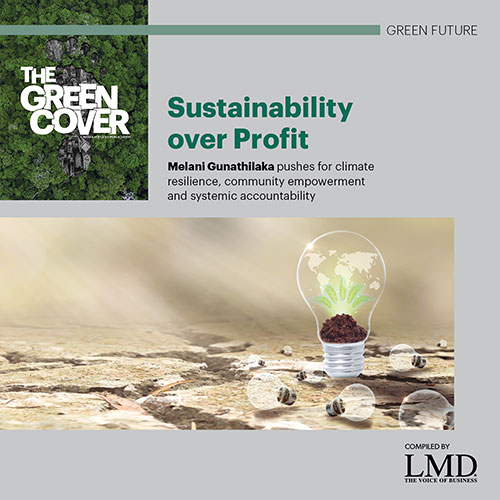COMMERCIAL BANK

Q: With Sri Lanka facing unprecedented economic, social and political challenges for some time, how do you view the island’s conservation status in terms of the natural environment?
A: The current landscape in Sri Lanka reflects a significant level of public awareness regarding environmental conservation. Notably, the private sector has intensified its efforts, both in raising awareness and actively participating in conservation initiatives.
Sri Lanka garnered international recognition, particularly through its designation as a UN World Restoration Flagship for its commendable mangrove restoration endeavours.
However, much more needs to be accomplished to safeguard our natural environment. A comprehensive and robust action plan is the order of the day, which engages all stakeholders.
Only through a cohesive effort – with each party fulfilling its responsibilities – can we effectively preserve and protect Sri Lanka’s invaluable ecosystems for future generations.

Managing Director/Chief Executive Officer
Q: What is the role of corporates in the effort to make Sri Lanka green?
A: The journey to make Sri Lanka green requires collective responsibility from all its citizens, encompassing the government, legislature, public and private sector organisations, and individuals.
The government and legislative bodies play a crucial role, in formulating policies and laws that prioritise environmental protection. Organisations, both public and private, have a responsibility to improve their environmental footprints through sustainable manufacturing processes.
Encouragingly, many corporates are deeply committed to these principles, actively pursuing strategic initiatives to promote environmental sustainability, often in collaboration with the government and industry organisations.
Q: What does corporate sustainability mean for your organisation?
A: Corporate sustainability is increasingly recognised as essential for ensuring long-term growth that aligns harmoniously with both people and the planet.
At Commercial Bank, corporate sustainability serves as the guiding principle woven throughout our long-term strategic planning across various business sectors. It acts as the cohesive force driving us towards our shared objectives.
Our approach to corporate sustainability is comprehensive and inclusive, involving all stakeholders in diverse and multifaceted initiatives aimed at fostering sustainability. We adhere to a meticulously crafted sustainability strategy, which rests on three key pillars: sustainable banking, responsible organisation and community impact.
These pillars encompass eight core areas, all in alignment with the 17 Sustainable Development Goals (SDGs) outlined by the UN. Our unwavering dedication to corporate sustainability is symbolised by the introduction of a redesigned corporate logo, now featuring a prominent green element.
Q: Is the shift to greener solutions impacting organisations in your sector?
A: Though banking operations contribute relatively little to environmental degradation directly, institutions are progressively transitioning to paperless operations, renewable energy and digital banking channels, and striving to minimise their operational carbon footprints.
Moreover, there’s a growing emphasis on promoting green initiatives, both in product development and lending practices. This underscores the sector’s commitment to environmental sustainability and responsible stewardship of resources.
Q: How do you identify environmental impacts and risks? And what policies are in place to minimise these?
A: Our Integrated Risk Management Department examines all facets of risk, internally and externally. Environmental risks linked to lending projects undergo thorough scrutiny through a comprehensive Social and Environmental Management System (SEMS) framework.
Additionally, our supplier selection and evaluation processes meticulously assess the social and environmental impacts of our supply chain.
We employ a robust grid assessment model, evaluating economic, environmental, social, human rights, societal and product responsibility factors, to rank their significance to our operations and materiality to stakeholders.
Our credit policy and lending guidelines unequivocally outline our commitment to being a ‘responsible leader,’ emphasising the avoidance of transactions and activities detrimental to the environment.

Q: What recent initiatives have been taken by your bank to protect the natural environment?
A: Our commitment to environmental conservation encompass reforestation of 100 hectares in Kandegama and a nationwide initiative to plant 100,000 trees, underscoring our dedication to sustainability on a broader scale.
Our mangrove protection efforts closely align with the national mangrove protection initiative. To date, we’ve successfully replanted over 12,000 mangroves, receiving continued support from local communities, and governmental and nongovernmental organisations.
Additionally, our marine turtle conservation project played a crucial role in preserving the natural habitats of over 85,000 baby turtles, ensuring their safe release into the sea. We have established a ‘Future Force’ to drive internal engagement where employees volunteer for activities such as beach cleaning initiatives.
Telephone: 2486000 | Email: info@combank.net | Website: www.combank.net





